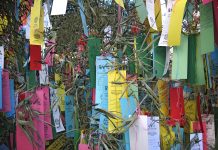
“If a race has no history, if it has no worthwhile tradition, it becomes a negligible factor in the thought of the world, and it stands in danger of being exterminated.” – Dr. Carter G. Woodson
Black History Month is celebrated every February in the United States and Canada, and it is celebrated in October in the United Kingdom. During this month, greater emphasis is placed upon educating, honoring and celebrating the countless accomplishments, events and individuals of the Africa Diaspora culture.
Black History Month was originally celebrated as “Negro History Week” and was created by Dr. Carter G. Woodson (Dec. 19, 1875 – April 3, 1950) and The Association for the Study of Negro Life and History (ASNLH) in 1926. This celebration took place during the second week in February in remembrance of two persons, President Abraham Lincoln (Feb. 12, 1809 – April 15, 1865) and Frederick Douglas (c. Feb. 1818 – Feb. 20, 1895, born Frederick Augustus Washington Bailey), a renowned African-American activist, author and orator. Both Dr. Woodson and ASNLH believed these men were integral to advancing the Negro cause for equality and education. While President’s Lincoln birthday is February 12, it should be noted that Frederick Douglass, who had been born into slavery, did not know his date of birth. Because many enslaved Negroes were considered property or chattel, it was general practice not to take note or record the dates of slaves’ births or deaths. Also, knowing something so personal as one’s birthday could be considered contradictory to the pervasive ideology at that time that Negroes were subhuman. If Negroes were human, after all, then they would be due certain “natural, inalienable rights” as were other men in the United States.
Tragically, this lack of knowledge of one’s own self is an all-too-common occurrence for many persons of African descent who suffered and survived the cruel American system of slavery. In slave-holding states, it was often the practice for children to be separated from their parents, especially their mothers. Douglass was no different. He had little memory of his birth mother, Harriet Bailey, other than infrequent night visits as she was forced to walk many miles on her infrequent “off” days to see young Frederick. Douglass never knew his birth father, although it is rumored he was actually Frederick and Harriet’s owner. It would be years later, upon his successful escape to New York, that Douglass would change his last name. Several accounts state he selected Douglass in admiration of politician Stephen Douglas. Other sources say abolitionist Nathan Johnson suggested the new surname to him after Douglas, one of the prominent characters featured in Sir Walter Scott’s epic poem, “The Lady of the Lake.” In either instance, Frederick chose to add an extra “s” to his new surname and selected Feb. 14, Valentine’s Day, as his birthday in honor of the love he held for his mother Harriet.
In creating Negro History Week, Dr. Woodson and ASNLH’s main goal was to incorporate the history of the Negro in America into the public school systems. Together they developed and provided literature and materials to educators to assist them in their instruction on Negro history. Although their effort did not initially enjoy the reception Dr. Woodson and the association hoped for, they remained motivated and continued working toward their goal and by 1929 every state with a significant Negro population knew of Negro History Week. Additionally, Negro churches also became great supporters of Negro History Week, as they too were recipients of ASNLH materials and instruction.
During the Black Power movement in the United States during the 1960s and 1970s, Negro History Week experienced two significant changes: the demands for “Negro” to be changed to “Black,” which many practitioners felt commanded greater respect; and for its celebration to be extended to the entire month of February. The inauguration of February as “Black History Month” occurred in 1970 across university campuses but Black History Month was officially recognized by the American government in 1976 during the bicentennial of the United States.
Discussion during the late 1980s and 1990s centered around changing the title to “African-American History Month,” but as a scholar and educator of African culture, I still call it “Black History Month,” as many who are studied and acknowledged during Black History Month in the United States are not African-Americans. This includes notable persons such as Queen N’Zinga of Angola; former President Nelson Mandela of South Africa; former President Jomo Kenyatta and environmentalist and women’s rights activist, Dr. Wangari Maathai, both of Kenya; orator, publisher and political leader, Marcus Garvey and singer and activist Bob Marley, both from Jamaica; Emperor Haile Selassie of Ethiopia; Mansa Sundiata and Mansa Musa, both of Mali; anthropologist and historian, Dr. Cheikh Anta Diop and poet and culture theorist, President Léopold Sédar Senghor of, both Senegal; poet and politician Aimé Césaire of Martinique; and entrepreneur Folorunsho Alakija of Nigeria. Also excluded would be global ideologies and movements such as the highly significant Pan-Africanism, which promotes the unity of persons of African descent throughout the Africa Diaspora; and major events such as “The Year of Africa-1960,” when seventeen countries, including Cameroon, Chad, Ghana, Mauritania and Niger, regained their independence from European colonialism, domination and oppression.
This adoption and the proper re-insertion of persons of African descent into world history would surely have brought pride to Dr. Woodson. A graduate of Berea College and the University of Chicago, he would be the second “Negro” in history to earn a doctorate from Harvard University, (Dr. W.E.B. DuBois was the first). Dr. Woodson, with Reverend Jesse E. Moorland, founded the ASNLH in Chicago, Illinois, on Sep. 9, 1915. It is currently called the Association for the Study of African American Life and History (ASALH), indicative of the changing cultural times. There are numerous chapters throughout the United States. It is the mission of ASALH to carry forth Dr. Woodson’s and Reverend Moorland’s critical work and to continue to build upon the “powerful legacy of speaking a fundamental truth—that Africans and peoples of African descent are makers of history and co-workers in what Dr. DuBois called, ‘The Kingdom of Culture.’”
As the vice president of the Paul Laurence Dunbar Branch of ASALH, I proudly work in cooperation with the national chapter in “promoting, researching, interpreting and disseminating information about the lives, histories and cultures of African-descended peoples to the global community.” Dr. Woodson’s vision has inspired other groups to devote a month to educate a broader audience and celebrate their culture (Women’s History Month, National Hispanic Heritage Month, etc.). I am immensely honored to build upon the work of Dr. Woodson and celebrate Black history, 365 days a year, every year!
Photo courtesy of Flickr, Creative Commons.


































